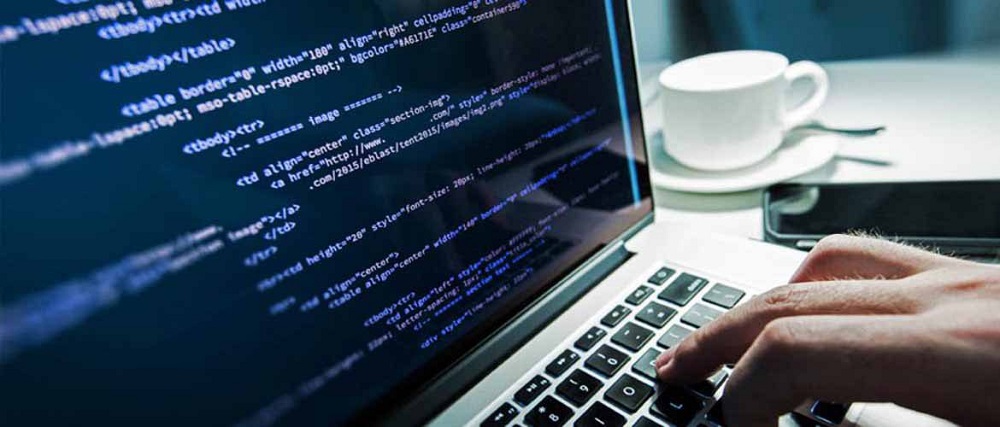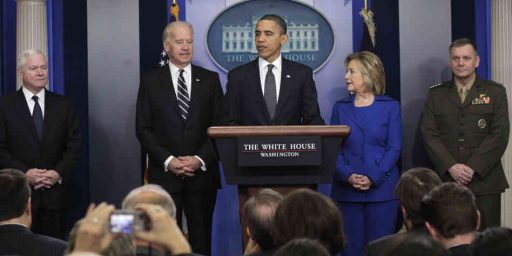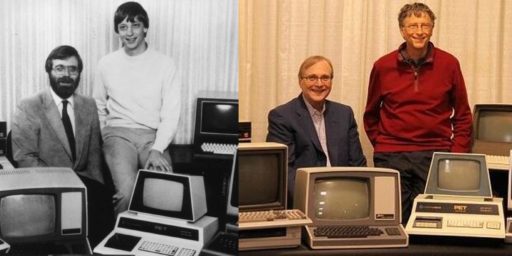COVID’s Silver Lining?
The pandemic forced the spread of useful technology.

Fortune/YahooNews (“‘I think that is a very positive thing’: Bill Gates explains the digital silver lining to the COVID pandemic“):
The pandemic is often only discussed with regard to its negative impact on mental health, but Bill Gates has pointed to COVID-19 as a catalyst for the world being digitized at warp speed.
The Centers for Disease Control (CDC) reported last month that more than a third of high school students experienced poor mental health during the outbreak, and 44% reported they persistently felt sad or hopeless in 2021.
As the Microsoft founder on CNN’s Fareed Zakaria GPS on Sunday recalled: “The idea of videoconferencing was very much a niche thing.
“You know, it’s been at world fairs forever, [but] there were a few people who did that.”
Gates, who also recently spoke about his experiences with vaccine conspiracy theories, noted that everything changed in the pandemic, where all engagement was forced to be done digitally, leaving irreversible effects in the medical and psychological fields.
“The software improved a lot. I think the medical vertical, particularly for behavioral, mental type consultation, will be forever changed,” he said.
“I think that is a very positive thing. And the software involved is going to get a lot better. I wouldn’t underestimate that accelerated digitization including in health and education substantially,” Gates said.
It takes a special kind of mind to look past widespread mental health issues and the fomenting of conspiracy theories that have led to tens of thousands of unnecessary deaths to see that the technology that contributed to it will ultimately be beneficial. But he’s surely right.
Zoom School is a disaster if it’s a long-term substitute for in-person interaction. It’s next to impossible to delivery elementary or special education effectively at scale through video conferencing. Even at the collegiate level, it’s far less than ideal. But, used in a targeted way, it’s a huge boon. Maybe the teacher or one of the students needs to stay home for some reason but can still dial in and participate; that option never occurred to most of us two years ago.
And we’ll likely save massive amounts of time and money holding meetings that used to require airplane flights via Zoom or similar tech. It’s not a perfect substitute and there’s something to be said for face-to-face engagement. But, now, there’s a viable and extremely inexpensive option between the phone call and the in-person.
I haven’t paid that much attention to the advances in telehealth but the prospects are obvious. If nothing else, it will save patients from having to sit around in waiting rooms with other sick people, fuming that the doc is behind schedule. And it would seem to allow people in relatively remote areas much easier access to highly-specialized experts.






I have really mixed feelings about this type of argument. It definitely falls into a technological utopian bias that Gates and others like him have.
It’s also a bit too reliant on looking to technology versus weighing the role of business/organizational policy. All of these orgs could easily choose to cancel WFT/remote work or return more or less to “old school” business travel if they wanted to. And while there definitely would be grumbling from staff, the reality is as with most things, the majority of folks would go along with it.
I do think he and you are correct about some points:
1. There has been a net benefit on reducing extreme travel in most cases. This isn’t good for the airline industry, but its most likely a long-term positive for everyone else (including reducing pollution).
2. Telemedicine being normed is ultimately a good thing and again a net positive. I remain skeptical if it’s true benefit on mental health yet. While tele-sessions are great the pandemic has also demonstrated a lot of the issues with our mental health system, including a lot of issues with insurance being taken putting treatment outside the bounds of many people. Which again gets back to the issue that these systems are a lot more than just the tech.
3. It has been a potential boon for folks with disabilities. For years, people with mobility or other disabling issues that prevent them from traveling far away from their homes have been told that if they can’t come to the office, they can’t work. The pandemic has shown that isn’t the case and has opened up a lot of possibilities for those folks to actually begin careers. Now the question is whether or not that can continue post pandemic. And that again gets back to business policy versus techology.
@matt bernius: My experiences so far with mental health services being provided over Zoom are not good. I resent being told I have to pay full price for my daughter’s check-ins with the psychiatrist who diagnosed her with ADD, I mean, at MOST it’s been a 15 minute Zoom call and he’s charging me for a full hour. She doesn’t feel like she’s getting any benefit out of it, either, other than the medication has helped improve her focus at school. We can get that prescription from a medical doctor.
At work, the need for ventilation resulted in a directive to keep all doors and windows open. This has allowed people coming to visit our department’s space to just walk in. Previously, they had to knock on the door, and someone had to use a fob to unlock it.
Given that we never screened anyone who wanted to come in, but just unlocked the door at every knock, this represents a 100% reduction in the number of door related interruptions all of us in the office with the door have to endure. This means me above all, as the boss insisted I keep one of the two fobs at my place, because I tend to get in earlier than everyone.
@Jax:
Are those at least covered by insurance?
I get the frustration and, FWIW, I will say that seeing a psychiatrist for any mental health drugs is generally a better option than a GP. They tend to be more up on the literature and are of much more assistance when something goes wrong. As someone who’s had issues in the past dialing in on the right prescription, I see the value. Once everything is set, there shouldn’t be a need to see them on the reg (beyond a once to twice a year check-up depending on medication) unless something is going wrong.
The pandemic has given a boost to the development of mRNA uses.
https://www.cancer.gov/news-events/cancer-currents-blog/2022/mrna-vaccines-to-treat-cancer
Several interesting lines of research are out there.
Remote doctoring is something I am skeptical about. Real understanding between people is hard to achieve, but it is integral to healing. Communication requires more than words; my dog understands me despite having limited language skills. A screen removes that creature to creature touch. Our emphasis on science has resulted in technological care that often achieves truly amazing things, but we have a gap in the heart to heart aspects of the healer’s art. This gap is filled by all kinds of hooey and causes things like anti-vaccination ideas. Further disconnection could easily worsen this gap and give more room for flourishing of fake medicine.
@Matt Bernius: No insurance. We fall in one of those gray areas where I make just a little too much above the income requirement for Medicaid (Wyoming never expanded it) to cover the kids, and Healthcare.gov keeps kicking it back to Medicaid when I apply every November, then they say no, you make too much. It’s a vicious circle.
I had one remote consult with a hematologist early in 2021. He pretty much was able to take my medical history, note current symptoms (none), learn why the gastroenterologist referred me to him, and tell me what blood tests I needed (he emailed the prescription).
The blood tests were fine, but he wanted to do an exam of my lymph nodes. That required an in-person visit. Discounting travel and wait time, this was shorter (and nothing turned up).
I’ve had engineering teams with various members scattered around the country or world for decades, and there is nothing about Zoom technologies that wasn’t available ten years ago. But there are two huge differences nonetheless: cost and use modes. Cost has essentially come down by an order of magnitude. I was paying over a hundred dollars a month for each individual on my teams so they could have video conferencing and now it is just another feature of our Microsoft Office subscription. As far as use modes, it is now the norm to turn on the f*cking camera. It makes such a difference in conveying information but it was so hard to get people to do it for so many years. Be professional people! Show up!
@Slugger, great point about mRNA… that points out a personal bias that I didn’t think about that as “technology.”
@Jax, ugh, I’m so sorry to read that. I cannot imagine the frustration you go through. And you’re exactly the type of family our social safety net continues to fail.
Many months ago there was an article on NPR about tele-health and law. Apparently, many states require in-person visits (why??) but allowed for tele-health during the height of the pandemic.
The data gathered through that period was being presented as evidence to support allowing tele-health full-time. While the doctors did not suggest that the quality of care increased, they pointed out that access did. It wasn’t just the infirm or handicapped that got more interaction with doctors, it was people who couldn’t afford to take time off of work, or who lived far from the clinics (e.g., rural areas). Those people could consult with the physician via computer, or even phone, and get some basic to medium care.
@Matt Bernius:
Well, actually mRNA does grow on trees 🙂
@Mu Yixiao:
Unfortunately, it’s probably because fraud is so rampant in the healthcare industry and false billing for telehealth would be all that much easier to get away with.
I think in the 90s, a teleconference meeting involved getting your people to a teleconference company in your town, and the people you intended to meet doing the same thing in their city. The company involved made a TV hook up between what were really TV studios made to look like conference rooms.
I suppose it was less expensive than flying a dozen people elsewhere. It certainly took up less time, and you could send more people to the meeting.
But then, I also recall when Fax machines seemed revolutionary. Not to detract from them, but I was glad when they were deposed in favor of email and messaging apps. I recall wasting a lot of time calling people asking to re-send a fax because the one we got was illegible.
@Jax and Matt Bernius:
After my son was diagnosed with ADHD and the pediatric psychiatrist established his meds, we only ever had twice-annual meetings with the physician’s assistant whose job was only to monitor and flag any changes, which then would have gone back to the psych. More efficient and much cheaper.
James said:
OK reality check. Schools made the transition from in person to ZOOM in a matter of days (Higher Ed as well) and spent the next year trying to fly the plane while building it. There is no way that was going to work. In order to to deliver content like that you need and army of instructional designers creating the content and then the instructors need to learn a whole new way of teaching to deliver it. If you wanted to do this right you would need something on the order of 20 hours for every hour of delivered content. So what you are saying is hastily cobbled together instruction delivered by untrained instructors was a disaster.
Let’s not throw the baby out with the bath water. I work at a university on just this issue, I have a thorough background in technology and a masters in instructional design and I can tell you that what was going on was little more then a stop gap measure and never really evolved beyond that. So to say that remote leaning is a “disaster” is an opinion coming from evaluating a situation that never had any real thought put into it, being delivered by instructors that didn’t have any training in it and many who were actively hostile to the whole idea who had to come up with the methods that were beyond their training.
However there were a lot of examples of teachers that did stumbled across content and a delivery who did rather well. They were few and far between considering they were trained the in-person style of teaching taught in every single teacher prep program in the universe. The point is that remote learning should be judged on programs that were well thought out and prepared rather then the nonsense that was thrown together. We should not be so quick to dismiss it of hand.
If there is a reason not to do remote learning it’s because in the long run it’s probably more expensive to do it right then it is to simply use the traditional in person model. Remote learning can be incredibly effective when done right and I know at least two friends who tutor using remote tools with excellent outcomes. My fear is that the idea remote learning has been tested and proved a failure is either someone pushing an agenda, or just doesn’t know Enghouse about what they are talking about to have an informed opinion.
I have been using remote tools since the 90’s that I find them invaluable in my work. The fact that everyone else had a crash course has pushed that technology out of the realm of geekdom. It would be a mistake to call remote learning an abject failure based on what happened during the pandemic. I can guarantee something like this will happen again and we really need to be better prepared.
@Rick DeMent:
While I wouldn’t call it a disaster, remote learning is certainly much inferior to in-person.
I was teaching via Zoom before any of this happened (early 2018), with mostly adult students. Compared to in-person it was much more difficult and much “choppier” (the classes don’t flow as well). I can only imagine what it’s like with kids.
@Jax:
My shrink has gotten down to using 15 minutes of a 30 minute video meeting for drug maintenance checks.
He goes through his list of screening questions, I answer that everything is fine, he asks about new stresses and life changes, and we’re done.
I don’t get anything from it because everything in going fine. Your daughter might also be doing fine.
We raised my dose after a stress based heart arrhythmia, after getting a new job and a pandemic started — we took the full half hour that time, and had more frequent check ins, and then similar when I was so fuzzy-headed that we decided to lower my dose… both of those times it felt like the half hour was too rushed. I’m not convinced the answer is to block out a full hour in case it is needed.
@Mu Yixiao: If we accept that remote and in-person are different, we have to consider the possibility that *you* are better at one or the other.
I would expect that research would show that remote is not as effective for most classes, but I don’t know that.
I would also expect teachers to blame the new tools when things don’t go well.
Counterpoint: I’ve learned much more from some of the Great Courses audio series on Audible than I learned in many of my college classes. I suspect these are really good teachers on subjects I am interested in, and there was a lot of trial and error to get the lessons to work well in this format… and that some of my college teachers sucked.
@Rick DeMent: No training? What are you talking about. I watched 3 full PowerPoint slide shows, each in excess of 15 minutes, on Screencastify, Zoom, and Google Classroom. I got as much training as anyone.
@Gustopher:
Same here, but with a caveat. I learned more also than from my first and third year high school history teacher, but only because these lectures can take up more time. That teacher, call her Mrs. H., was remarkable.
The do claim a selection criteria for teaching excellence.
In my experience that’s a big NO, because actually seeing the psychiatrist all depends on how much of your day you can afford to waste, where as seeing my NP (I gave up on seeing Docs, unless it’s a surgeon) is as easy as making an appointment early in the day and showing up on time.
@Jax: Have you tried working with an insurance broker? Sometimes they can help just because they know how the system works and the ways to trick into doing what it doesn’t want to.
@OzarkHillbilly: I honestly think there’s something hinky going on at Wyoming’s Medicaid office. Healthcare.gov applied for me on November 20th, and I didn’t know they were still doing that, so I applied December 13th. I’ve called every two weeks since then, and get told the same thing every time “Applications are processed in the order they’re received”. They’ve never requested more information on my finances or anything and it’s the middle of May. Their website is trash, they make you pick a new password every three months, so when I went to change my password, they asked me security questions that are not questions I would’ve ever picked…..so of course I can’t answer them correctly, because I didn’t pick them in the first place. When I called Customer Service on THAT, it was a 45 minute wait, only to be told the website was “experiencing difficulties”.
I think they’re purposely slow-rolling applications. Surely they can’t be THAT incompetent?! 😛
From my POV it seems like the teleconferencing suddenly started working better. My past experiences were poor. Then Zoom, Webex and TEAMS came along and they generally worked (I did think Zoom spotty early on) well and reliably. I was really pissed when they made us switch to TEAMS at the start of the pandemic but I am now a fan as it has utility well beyond online communicating. Telehealth has always created issues people weren’t sure how to deal with, especially the insurers. I think it will now hang around and get used a lot more.
Steve
@Jax:
Your comment is insightful. Anyone with even a cursory knowledge of mental (or physical) health care knows that the first hand experience is crucial.
I’m not saying a common cold or sinus infection interview can’t be conducted by Zoom. But mental health issues? No.
@steve:
C’mon, steve. I’m sure certain 1st round screenings are fine. I’m sure common ailments are, most of the time, fine. But seriously, mental health issues are very delicate. And as my doctor father (and my grandfather) always noted, the in person history and first hand observation were crucial.
You guys are trained for that. Doctor by robot is narrowly appropriate.
Follow up visits with surgeons, most GI doc visits, dermatologists. There are a number of specialties and times where telehealth can be used. Heck, ICU care benefits. Smaller hospitals that have ICUs dont have in house docs. Nurses manage by protocol but if they have questions they call the on call doc. By adding a telehealth service you get a doc who is already up and working, not waking someone, and a second set of eyes and someone the nurse can turn to about management questions. It wont work for everything but it works for a lot of stuff.
Steve